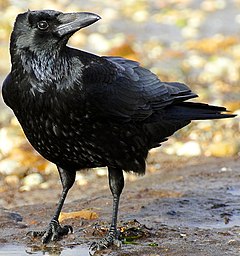Carrion crow
| Carrion crow | |
|---|---|
 |
|
| Scavenging on a beach in Dorset, England |
|
| Scientific classification | |
| Kingdom: | Animalia |
| Phylum: | Chordata |
| Class: | Aves |
| Order: | Passeriformes |
| Family: | Corvidae |
| Genus: | Corvus |
| Species: | C. corone |
| Binomial name | |
|
Corvus corone Linnaeus, 1758 |
|
 |
|
| Carrion crow range Year-Round Range Summer Range Winter Range | |
The carrion crow (Corvus corone) is a passerine bird of the family Corvidae and the genus Corvus which is native to western Europe and eastern Asia.
The carrion crow was one of the many species originally described by Linnaeus in his 18th century work Systema Naturae and it still bears its original name of Corvus corone. The binomial name is derived from the Latin Corvus, "Raven", and Greek korone/κορωνη, "crow".
The hooded crow, formerly regarded as a subspecies, has been split off as a separate species, and there is some discussion whether the Eastern carrion crow (C. c. orientalis) is distinct enough to warrant specific status; the two taxa are well separated, and it has been proposed they could have evolved independently in the wetter, maritime regions at the opposite ends of the Eurasian landmass.
The plumage of carrion crow is black with a green or purple sheen, much greener than the gloss of the rook. The bill, legs and feet are also black. It can be distinguished from the common raven by its size (48–52 cm or 18 to 21 inches in length as compared to an average of 63 centimetres (25 inches) for ravens) and from the hooded crow by its black plumage, but there is frequent confusion between it and the rook. It has a wingspan of 84–100 cm or 33 to 39 inches. The beak of the crow is stouter and in consequence looks shorter, and whereas in the adult rook the nostrils are bare, those of the crow are covered at all ages with bristle-like feathers.
The carrion crow (Corvus corone) and hooded crow (Corvus cornix, including its slightly larger allied form or race C. c. orientalis) are two very closely related species whose geographic distributions across Europe are illustrated in the accompanying diagram. It is believed that this distribution might have resulted from the glaciation cycles during the , which caused the parent population to split into isolates which subsequently re-expanded their ranges when the climate warmed causing secondary contact. Poelstra and coworkers sequenced almost the entire genomes of both species in populations at varying distances from the contact zone to find that the two species were genetically identical, both in their DNA and in its expression (in the form of RNA), except for the lack of expression of a small portion (<0.28%) of the genome (situated on avian chromosome 18) in the hooded crow, which imparts the lighter plumage colouration on its torso. Thus the two species can viably hybridize, and occasionally do so at the contact zone, but the all-black carrion crows on the one side of the contact zone mate almost exclusively with other all-black carrion crows, while the same occurs among the hooded crows on the other side of the contact zone. It is therefore clear that it is only the outward appearance of the two species that inhibits hybridization. The authors attribute this to assortative mating (rather than to ecological selection), the advantage of which is not clear, and it would lead to the rapid appearance of streams of new lineages, and possibly even species, through mutual attraction between mutants. Unnikrishnan and Akhila propose, instead, that koinophilia is a more parsimonious explanation for the resistance to hybridization across the contact zone, despite the absence of physiological, anatomical or genetic barriers to such hybridization. The carrion crow is also found in the mountains and forests of Japan and also in the cities of Japan.
...
Wikipedia

